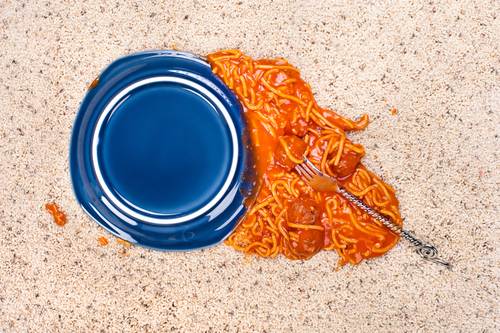In the case of dropped food, believers in the “five-second rule” now have a scientific study to back up their food-from-floor-to mouth practice — as long as they are fast. The five-second rule states that food dropped on the ground is OK to eat if it has been there for five seconds or less. The rule is either treated as old wives’ tale, or is followed to justify eating a fallen treat. It was previously debunked by the Mythbusters, who found that bacteria can be transferred to food in as little as two seconds.
The Mythbusters may need to give their experiment another go, or team up with Aston University in England. At Aston University, final-year biology students led by professor of microbiology Anthony Hilton put the five-second rule to the test.
In their study the students monitored the transfer of E. coli and Staphylococcus aureus from the floor to food from three to 30 seconds. Their variables included floor type (carpet, laminate or tiled surfaces) and food type (toast, pasta, biscuit and a sticky sweet food). According to a slideshow made by Hilton, provided to Salon by the school, they tested each floor type to see what bacteria already inhabited the the surface. The students also tested to see how long E. coli and Staphylococcus aureus could live on each of those surfaces.
The results revealed that not surprisingly time was a factor. A release from Aston University stated, “Food picked up just a few seconds after being dropped is less likely to contain bacteria than if it is left for longer periods of time.” According to the study, other major factors turned out to be floor surface and food composition:
“The type of flooring the food has been dropped on has an effect, with bacteria least likely to transfer from carpeted surfaces and most likely to transfer from laminate or tiled surfaces to moist foods making contact for more than 5 seconds. “
Carpet seems to be the safest spot to drop food for several reasons. E. coli and Staphylococcus aureus lived on carpet for the shortest period of time. Food composition mattered less when dropped on carpet, as opposed to tile or laminate, where both time and food composition made a perceived difference in bacterial transfer.
Drier foods like toast also had lower transfer rates of bacteria, as opposed to pasta or a sticky sweet.
This doesn’t mean that people can’t get sick from eating dropped food. Professor Hilton warns, “Consuming food dropped on the floor still carries an infection risk as it very much depends on which bacteria are present on the floor at the time.”
Along with the study the students conducted a survey to see if people do in fact eat food off the floor employing the “five second rule.” Turns out many do: 87 percent have or would eat food off of the floor. Of those who do, over half were women (55 percent), and of those women 81 percent follow the five second rule. The slides from professor Hilton show that 495 people responded to the survey (218 males and 277 females).
What can be concluded? The longer food is on the floor, the more bacteria it can pick up. Also, whether myth or fact, people still seem to eat food off of the floor. And perhaps there’s not much harm in following the five second rule, especially if you’re eating toast over carpet.
h/t Gizmodo and Aston University

